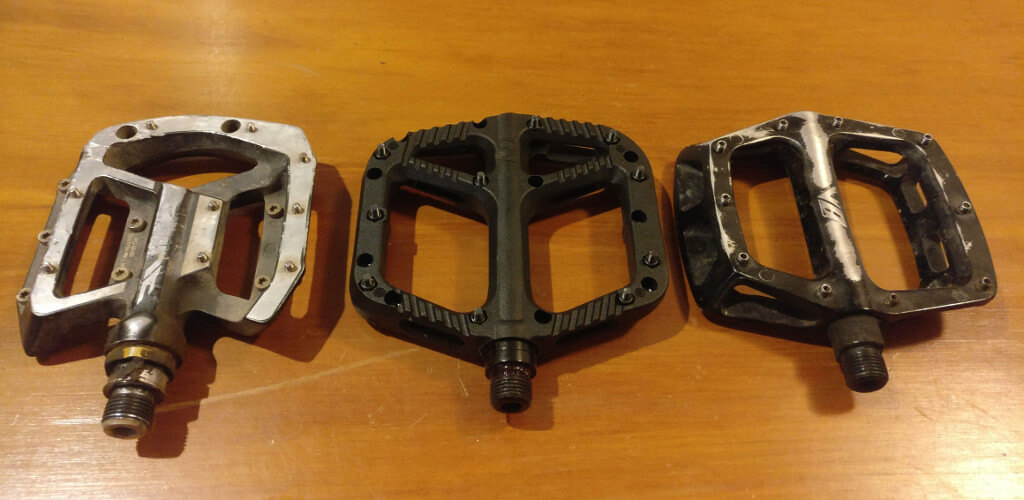Flat pedals are awesome.
And I’m not alone in this view – mountain bikers all around the World will talk your ear off about which pedals are better and why.
But my take on them is basically this – if you’ve got a decent set of flat pedals with a large platform and sharp pins, you’re off to a good start!
(Add some tacky soled mountain biking shoes to the mix, and you’re in business!)
Today we’re going to take a look at 3 sets of flat pedals I’ve been using lately on my mountain bikes, and compare the pros and cons of each, in a comprehensive review!
The contenders:
Shimano Saint (v1) Pedals
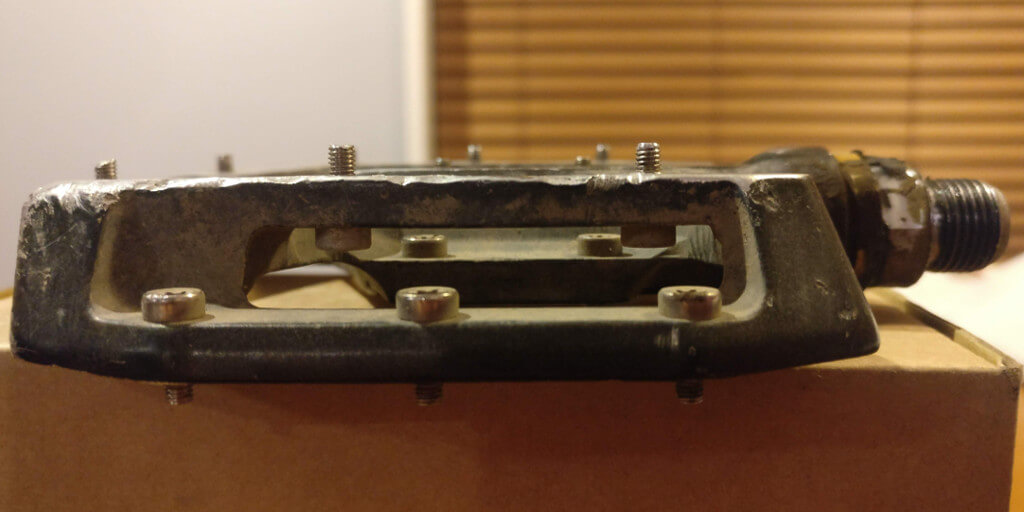
My set of these are looking pretty battered these days, and for good reason – they’ve been on my Bronson for the last six years or so, and have been used and abused during all sorts of “full enduro” riding 😀
They’ve been smashed into countless rocks, survived numerous crashes, and are still going strong after thousands of downhill runs.
All this and they have basically had only a handful of new pins added, and a few home DIY pedal rebuilds to fill them full of grease again – and they’re still running pretty sweet, despite all the metal gouges and bent pins!
DMR V8 Pedals
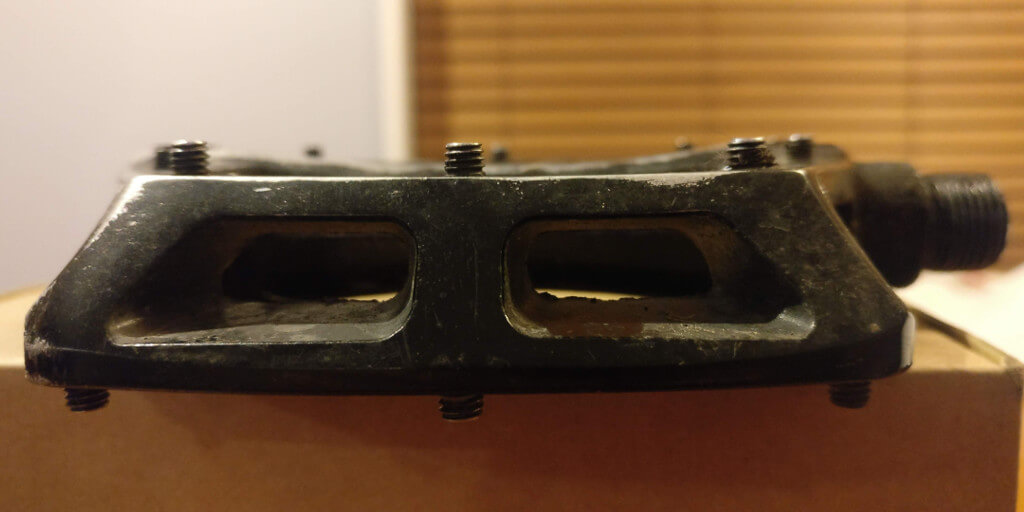
These have been on my latest hardtail for the last couple of years, and while they haven’t seen much trail riding, they’ve done many thousands of kilometers (that’s a couple thousand miles) commuting over that time.
The hardtail I bought only came with cheap plastic throwaway pedals, so I just needed something more solid with some decently grippy pins.
I didn’t want to pay too much – and I’d heard good things about DMR pedals, so decided to give them a try.
OneUp Composite Pedals
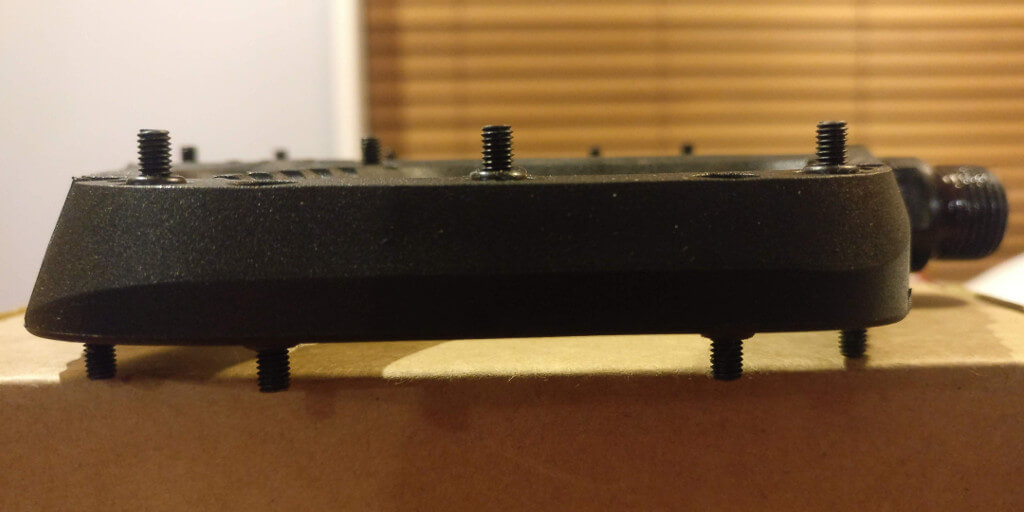
After many years of gradually grinding my Saints into metal fragments and munched pins, I recently decided it was time to invest in some new pedals for the Bronson – after all, they’re a pretty vital contact point with the bike, and I basically trust my life to them most weekends at the bike park!
I’ve also heard many great things about the OneUp pedals – both alloy and composite versions – and I’ve definitely loved all the OneUp components (like their awesome cheap chain guide) I’ve used on my bikes, so I wanted to give these a go.
I went with the composite model to save some money, but still get the wider platform and long pins that I was wanting from a new set of pedals on my main all rounder bike (that sees primarily downhill runs these days).
The only downside really with the composite is that they’re a couple mm thicker – but at 13.3mm at the leading edge where they’re thinnest, and 18.5 in the thickest part of the center, it’s fine by me.
Bike components just keep getting better…
It’s worth mentioning that with each passing year, shiny new bike tech is released (and some of it is even better than the previous stuff!)
Where flat pedals are concerned, there has been a trend towards thinner profile, larger platforms – almost all featuring beautiful grippy shin-gouging pins.
The confidence of grip that these sort of pedals provide is just awesome – and in theory, the thinner profile means more ground clearance, and less chance of clipping a rock and getting chucked over the bars (though the wider platforms naturally stick out further from the side of the bike when aggressively cornering and leaning the bike over of course).
The Specs:
So let’s take a closer look at these three pedals – how do they compare?

Let’s compare their weight, size (width, length, height), number of pins, profile and overall grip…
Here’s a handy comparison chart that I put together, after weighing the pedals on my kitchen scales.

Comparison and Experience
Shimano Saint (v1) Pedals
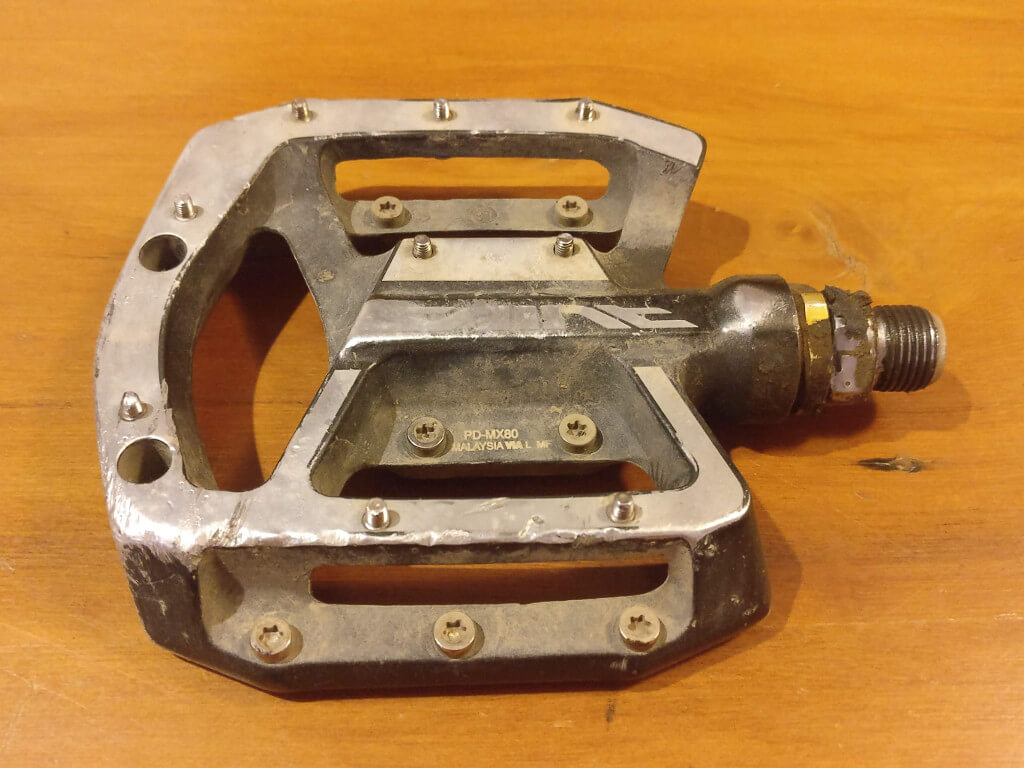
When I upgraded my very basic Wellgo flat pedals on the Bronson (full suss trail bike) to the Saints, it was a super noticeable change.
I had far more grip (especially when combined with my pair of FiveTen shoes).
It’s annoying that they come fitted with spacer washers under every single pin!. This shortens the pin, and dramatically reduces grip.
I removed them immediately.
The pedals felt well made, and I initially thrashed them for probably a couple of years with loads of downhill bike park runs and other goodness that made sure I was giving them a solid test!
Only then did they start to develop a bit of horizontal play.
One quick youtube video later and I was now an expert on how to service Saint pedals.
To be fair they are ridiculously easy to service.
All I had to do was:
- unwind the axle and remove it
- clean off what was left of the old heinous grease
- load it back up with fresh grease
- reinstall axle, and tighten
The pedal felt like new again.
Over the next 5 years I have only done that perhaps 3 times.
Gradually however, the grip has diminished. The main reason for this has been the pins getting smashed into rocks and worn down / crushed.
I’ve replaced a few of the worst pins each year, gradually working my way through a set of Shimano replacement pins.
That certainly makes a big difference – but a few are now no longer salvageable. Pins and/or threads destroyed by meeting a certain rock in just the wrong way.
One or two are mushroomed into oblivion on the outer corners of the pedals – which are themselves now deeply scarred by rock strikes.
The movement of the pedals is still good after years, and I haven’t noticed any structural issues.
But the platform just feels too small to me now though. Admittedly I do have size 12 shoes, so a larger pedal platform is likely to be a better fit right out of the gate.
I think these pedals were great in their day, but bike tech has moved on since 2013, and there are bigger, grippier, better flat pedals everywhere you look.
I’ve since swapped these out with a nice upgrade – which I’ll go into later.
DMR V8 Pedals
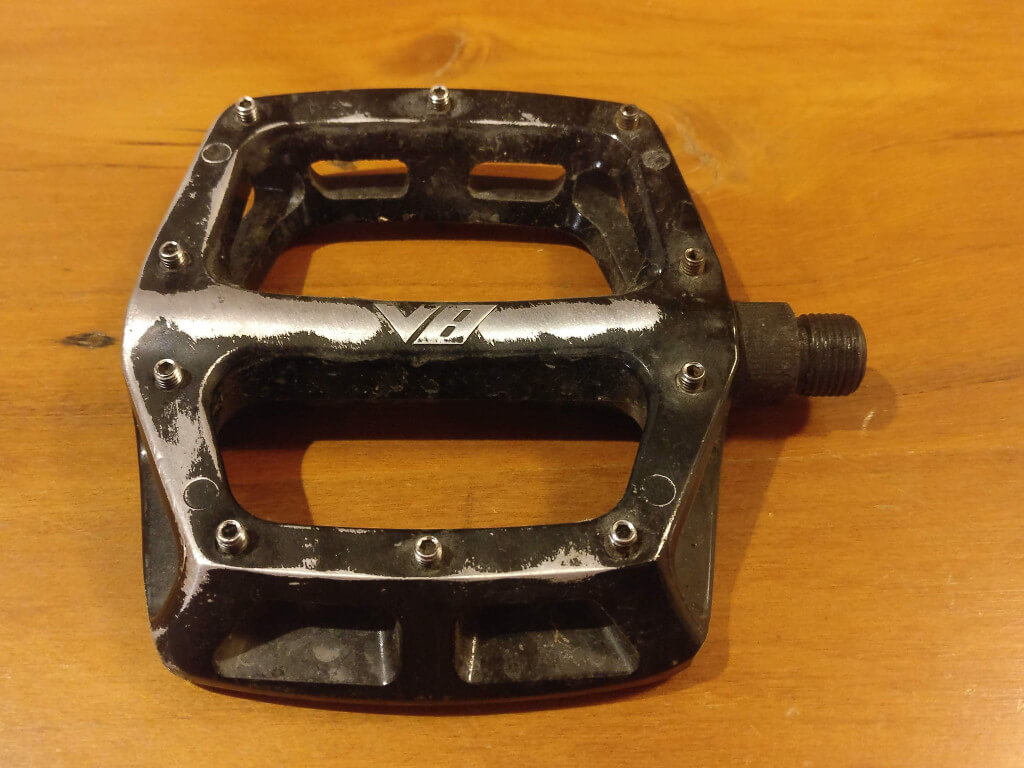
As mentioned previously, these were really just bought as a cheap pair of half-decent pedals to throw on my new hardtail.
I’d heard them mentioned various fellow riders over the years, so thought I’d try them.
Unfortunately I’ve never really been a huge fan of them.
There were a couple of main reasons for this I think.
Again a similiarly small platform, at least for my size 12’s. But also the chunky thickness of the whole metal pedal body.
The pins I found okay – but certainly not super confidence inspiring (though again this could definitely be exaggerated by the platform size).
To their credit they’ve done several thousand kilometers already over the last few years of commuting and general bike hi-jinks, with precisely zero maintenance.
Despite this, I just don’t enjoy them on my bike – which is a big part of any awesome mountain bike component in my books.
On the flip side, if something just makes the bike feel that much better – it’s a great thing, and I’ll keep coming back to those parts.
So, even though they lasted a long time without needing too much care, I won’t be purchasing another set of these pedals, regardless of the low price.
OneUp Composite Pedals
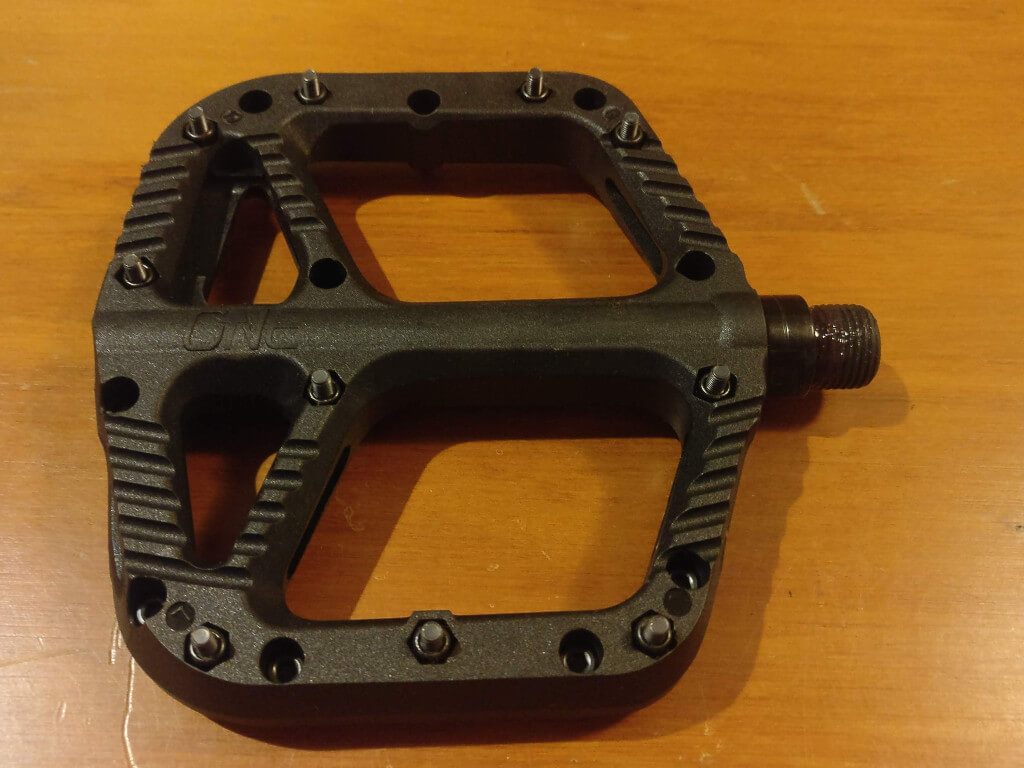
The latest addition to my full suspension trail bike, the Bronson, this is a much anticipated upgrade from my battered old Saints…
To this, a modern flat pedal – with a much larger platform, and a leading edge width of only just over 13mm.
So far, I love them. The bigger platform and 10 long sharp pins mean the grip is insane.
I am not looking forward to the day that they meet my shins.
And that day is most certainly coming.
I’ve been mountain biking long enough to know that (and I have the scars to prove it! :D)
But in the meantime I’m relishing the extra confidence that comes from an improvement in this vital contact point on the bike – if you’re into going “full enduro”, thrashing downhill laps, or otherwise tearing it up on your mountain bike, you’ll know what I mean I’m sure.
So are these the best MTB flat pedals around?
While the OneUp Comp pedals are most definitely a huge upgrade from my old Saints – this is not much of a surprise, given the age of the previous set, and the relentless advancement of bike component technology.
Pedals have come a long way over the last few years, like almost all bike components (and, it would likely be argued, bikes themselves).
But however better they feel right now, I’m still yet to see how well they weather my special blend of enthusiastic riding, and average skills over many years – which is how long I plan to use them!
Likewise, while I’ve heard good things in the past about a variety of different brands and models of flat MTB pedals, I’ve also witnessed firsthand the same pedals falling apart on the trail, which is definitely something I’d prefer not to experience.
But I’ve not heard of anything like that happening with the OneUps, and so far they’re going great.
I would buy them again for sure.
The question then is, would I try the alloy version, or stick with the composite?
Time will tell.

